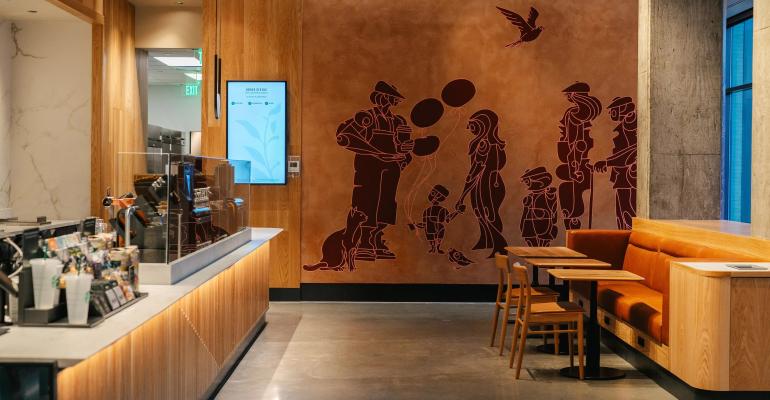On opening day of the new Washington D.C. Starbucks at Union Market, Emily MacKinnon was “nerding out,” she said. Through her work as the head of inclusive design, MacKinnon helped bring Starbucks’ first Inclusive Spaces Framework store into existence, and she was thrilled to hear customers’ reactions.
While features like easy-to-read order status boards, accessible paths of travel, and power-operated doors were created for, and in collaboration with, people with disabilities, the features were appealing to everyone.
She overheard a customer say he didn’t need to stand by the counter to hear his name called when his drink was ready, thanks to the order status board. She heard a woman wheeling luggage note how easy it was to maneuver throughout the store with its wide, unobstructed paths.
“Good solutions work across the board for a lot of people,” MacKinnon said.
Starbucks’s new location emphasizes how accessibility has evolved beyond the Americans with Disabilities Act (ADA) requirements. And it highlights a new way of thinking about accessibility; accessible design helps spaces feel more welcoming for everyone, not just the one in four Americans who identify as disabled.
Easy-to-activate power-operated doors — like those at the Starbucks’ Inclusive Spaces Framework store — may be the perfect example of an accessible feature that benefits everyone. These doors make the store more accessible for people with disabilities, parents with strollers, and customers balancing multiple drinks.
Technology can help everyone if it’s done right
Starbucks’s Inclusive Spaces Framework store, which includes a POS system with voice recognition and screen magnification, is an example of technology that makes a restaurant more accessible.
However, technology advancements can sometimes leave people behind.
Matt Ater, vice president of business development at Vispero, an accessibility consulting firm and an assistive technology provider for the visually impaired, has encountered such technology. Take mobile credit card readers. “Why does a blind person have to ask a waiter to do their own tips or, from a security perspective, put in your pin?” he said.
But his biggest concern is the rapid growth of kiosks. They’re used to streamline service and help alleviate bottlenecks when restaurants are short on employees. However, they can be challenging to navigate for some people with disabilities or people who are unfamiliar or uncomfortable with the technology.

Starbucks new bean-to-cup brewer, the Clover Vertica™, combines advanced engineering with accessibility features like a larger dial, visual and haptic confirmation and a light to notify partners when brewing is complete.
Through Vispero, Ater, who is blind, works with restaurants and other retailers to ensure their kiosks are accessible to all. Over the past few years, McDonald’s, a client, has updated many of its kiosks to include features like audio navigation, magnifying mode, and pictures.
These features benefit more than just the disabled population. They can also help support language diversity and make customers who aren’t comfortable with technology feel, well, comfortable.
We have an aging population that enjoys dining out, said Kimberly Knackstedt, the founder of Unlock Access, an accessibility and disability policy consulting firm.
“Are they going to be able to use some of the technology that we have? Not likely. And so when you have an aging crisis in our country, you have to think about that as far as disability inclusion accessibility,” she said.
Moving beyond the ADA to help everyone feel welcomed
A restaurant kiosk is just one element to consider when creating a restaurant that is truly accessible and welcoming. There’s a lot more to think about than ramps or accessible bathrooms or simply following the ADA guidelines.
“Accessibility seems hard. I think it’s like this big daunting thing, almost like an elephant in the room. But it’s not,” said Knackstedt, who worked with Starbucks on the Inclusive Spaces Framework and identifies as someone with a disability.
An important first step for restaurants is to consider the ADA the baseline and the bare minimum, Knackstedt said. It may be a new way of thinking for some operators. But all operators, ultimately, have the same goal: to offer great hospitality to all.

An updated handoff plane features an overhanging shelf and almost three feet of clearance underneath, providing lots of extra room for customers to approach with wheelchairs, power chairs, strollers and service dogs.
Think about accessibility as “cost of doing business, rather than as something you have to do later to make your business accessible,” said Peter Slatin, the founder of Slatin Group LLC, which provides training to the hospitality industry on serving consumers with disabilities. With that mind frame, he added, “it’s a totally different equation.”
Start by tackling specific areas of a restaurant, like paths of travel or seating areas, Knackstedt said. Ask experts for help and involve the disability community for advice and consultations. There are government resources, like regional ADA centers, and consultants who specialize in accessibility.
“Just be proactive and practical,” said Slatin, who is blind. “Recognize that this is a situation that involves everybody. The disability population is very large — if you’re a public company, many of your shareholders have disabilities.”
The disability community is large, but accessible spaces benefit even more of the population.
“We’re all aging into some level of accessibility,” Starbucks’ MacKinnon said. “When I think about my own eyes, I need readers. I can’t hear in a loud, crowded room. We’re all aging to a place that we would benefit from all the things that we are building.” Part of Starbucks’ Inclusive Spaces Framework includes an acoustic design that reduces noise and reverberation.
“It’s a shift in thinking that this is for a specific target audience — thinking about folks that have the biggest barriers day in and day out today,” she said. “Truly these experiences we’re building are really for all of us.”




